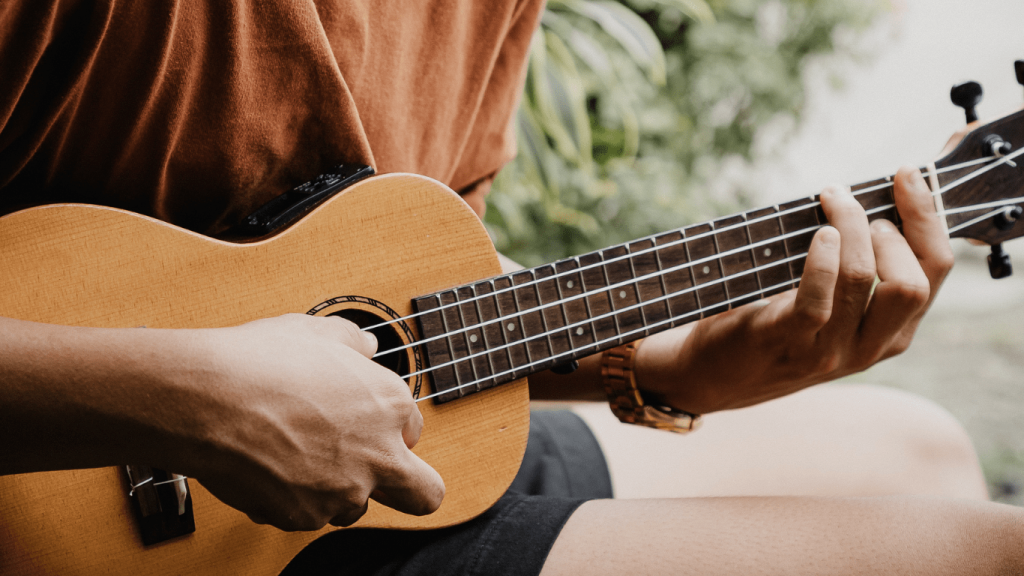Strumming is one of the most fundamental skills to master when learning the ukulele. Whether you’re a complete beginner or transitioning from guitar, knowing how to use various strumming patterns is essential for building rhythm and creating smooth, flowing music. In this post, we’ll explore several beginner-friendly strumming patterns for both ukulele and guitar, with step-by-step guides to help you get started.
Why Strumming Patterns Matter for Beginners
When you start learning an instrument like the ukulele, it’s easy to get focused on learning chords and melodies. However, without the right strumming patterns, your music can sound flat and lifeless. Strumming is the key to adding rhythm and groove to your songs, and it’s what helps bring your playing to life. As a beginner, mastering the basics of strumming patterns not only enhances your rhythm but also builds muscle memory and timing, essential skills for playing more complex songs later on.
As you improve, you may want to explore our ukulele classes for more personalised guidance and learning tips.
Basic Strumming Techniques for Ukulele and Guitar
Before diving into specific strumming patterns, it’s important to understand some basic strumming techniques that apply to both the ukulele and guitar:
Proper Hand Positioning
For beginners, keeping your strumming hand loose and relaxed is essential. A rigid hand will create harsh, uneven strums. Instead, aim for a relaxed wrist with gentle motions, allowing the pick or fingers to brush the strings without tension. Practice slow strumming to get comfortable with the movement.
Downstrokes vs Upstrokes
- Downstrokes (D): Strumming from the top of the strings to the bottom (toward the floor).
- Upstrokes (U): Strumming from the bottom of the strings to the top (toward the sky).
Downstrokes tend to have a stronger, more pronounced sound, while upstrokes are softer and subtler. Mastering both gives you the flexibility to create various rhythms.
Tips for Improving Strumming Accuracy
- Start slow: Don’t rush through the patterns. Begin at a slow tempo and focus on consistency.
- Use a metronome: Practising with a metronome helps you stay in time and develop a strong sense of rhythm.
- Focus on your wrist: Keep your wrist loose and fluid to avoid stiff movements, which can make strumming sound unnatural.
Essential Strumming Patterns for Beginners

Now that we’ve covered the basics, let’s dive into some beginner-friendly strumming patterns for both ukulele and guitar players.
Basic Downstroke Pattern (D)
The simplest pattern you can use, especially when you’re just starting out. This involves strumming downward on each beat:
- How to practice: Simply strum down on each beat (1, 2, 3, 4) in 4/4 time.
This pattern is perfect for simple, slow-paced songs where you just need a steady rhythm.
Down-Up Pattern (D-U)
The down-up pattern introduces both a downstroke and an upstroke:
- How to practice: Start by strumming downward (D), followed by an upstroke (U). This pattern alternates between the two, giving a flowing rhythm.
Songs that use this pattern: This is commonly used in folk and pop songs. You can easily incorporate it into songs like “Twinkle Twinkle Little Star” or “Creep” by Radiohead.
Down-Down-Up Pattern (D-D-U)
This is a great step up from the down-up pattern. The down-down-up pattern gives more emphasis to the first two beats and adds variation:
- How to practice: Strum downward twice (D-D), followed by an upstroke (U). This three-beat pattern is perfect for many beginners.
Example: Try this pattern with “Jingle Bells” or “Stand By Me.” It’s a simple but effective rhythm to get you used to quick transitions between strums.
Down-Up-Down-Up Pattern (D-U-D-U)
This is one of the most common strumming patterns you’ll encounter on both the ukulele and guitar:
- How to practice: Start with a downstroke (D), followed by an upstroke (U), and repeat the down-up motion.
This is a versatile pattern used in many songs across different genres, from pop to rock. Once you get the hang of it, you’ll be able to easily add it to your practice routine.
Split-Bar Patterns (D-U-D, D-D-U)
Split-bar patterns allow you to combine simple downstrokes with alternating upstrokes:
- How to practice: For example, try a “D-U-D” pattern for the first half of a bar, and a “D-D-U” for the second half. This creates a more dynamic and interesting rhythm.
This pattern is ideal for songs that shift between simple and more intricate strumming, giving them variety.
Tips for Practising Strumming Patterns
Start Slow
It’s tempting to try and play faster, but consistency and accuracy matter more when you’re learning. Start slow to ensure you’re hitting the right strings and timing the strums correctly.
Use a Metronome
A metronome helps you maintain consistent timing. Start at a slower tempo, and gradually increase the speed as you get more comfortable with the strumming patterns.
Change Chords Between Strums
As you practice strumming, make sure to switch between chords without interrupting your rhythm. This helps you get comfortable with strumming and chord transitions simultaneously.
Focus on Relaxation
It’s easy to get tense when you’re learning something new, but relaxation is key to smooth strumming. Keep your arm, wrist, and hand relaxed to avoid creating a stiff sound.
Applying Strumming Patterns to Popular Ukulele Songs
Here are a few songs that beginners can easily play using the basic strumming patterns outlined above:
- “I’m Yours” by Jason Mraz – This song uses the Down-Up pattern (D-U) and is a great introduction to ukulele strumming.
- “Riptide” by Vance Joy – A simple Down-Down-Up (D-D-U) pattern works perfectly for this popular ukulele song.
When to Seek Professional Ukulele Lessons
As you progress, you may find that professional ukulele lessons can help you refine your skills and build upon these basics. If you’re ready to take your playing to the next level, consider our ukulele lessons, where experienced instructors can guide you through more advanced techniques and patterns.
Conclusion
Mastering strumming patterns is a key part of becoming a proficient ukulele player. By starting with the basics, such as downstrokes, upstrokes, and the common patterns like D-U and D-D-U, you can build a solid foundation. Remember, consistency and practice are your best friends when learning any new instrument, and with time, you’ll be able to incorporate more complex strumming patterns into your playing.
For those looking to enhance their skills further, feel free to contact us at Studio 72 to book a lesson or get more personalised guidance. Keep practising, and enjoy making music with your ukulele!
FAQs
What are the easiest strumming patterns for ukulele beginners?
Starting with simple patterns like the Down-Up (D-U) or Down-Down-Up (D-D-U) is ideal. These foundational patterns help build rhythm and confidence.
How do I strum a ukulele correctly?
Proper strumming involves using a relaxed wrist and strumming from the elbow. Beginners often start with the index finger or thumb, strumming down on the downbeats and up on the upbeats.
Can I use a pick to strum my ukulele?
While traditional ukulele playing favours finger strumming, using a felt pick is acceptable. It can produce a unique sound, but it’s essential to experiment and find what feels comfortable for you.
How do I find the strumming pattern for a song?
Start by listening to the song and tapping along to its rhythm. Once comfortable, try strumming along while muting the strings to match the song’s feel.
How long does it take to master basic strumming patterns?
With consistent practice, most beginners can grasp basic strumming patterns within a few weeks. Regular practice is key to building muscle memory and confidence.






